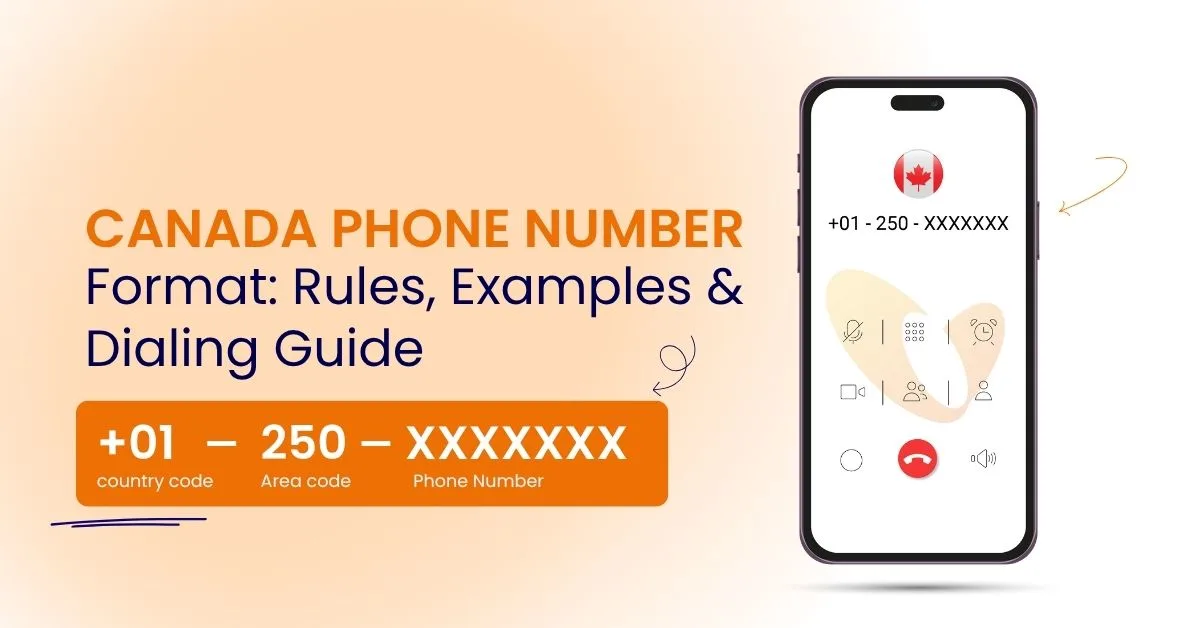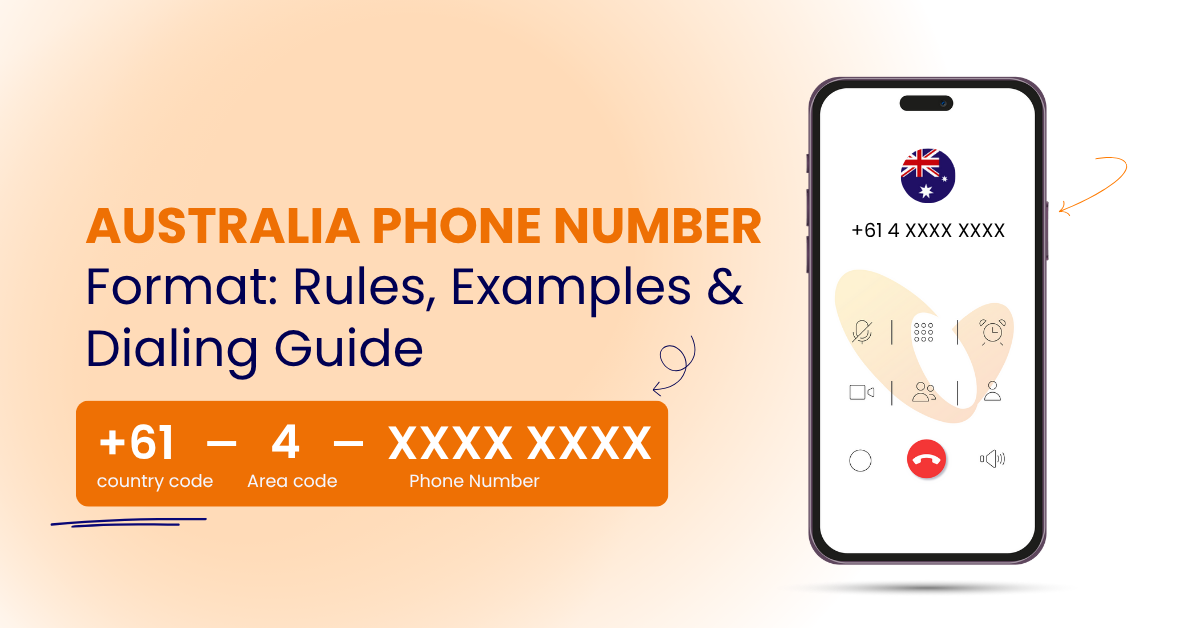India Phone Number Format Guide

6 min read
Table of Contents
India uses many types of phone numbers across mobile phones, landline numbers, toll-free lines, virtual numbers, and business communication systems. These Indian phone numbers often appear in different forms across websites, CRMs, forms, and mobile devices. When the Indian phone number format changes, systems get confused. A wrong number format can stop calls, block messages, or create duplicate records inside customer support tools.
A simple and consistent Indian phone number format removes these issues. It gives one structure that works across international calls, local calls, business expansion projects, and customer support teams. It also helps companies outside India reach Indian customers with a clear dialing format.
This guide explains the complete format for Indian phone numbers. It includes India’s country code, landline area codes, mobile prefixes, toll-free numbers, international dialing rules, and correct spacing for the right format. It also explains subscriber trunk dialing codes (STD codes), the number of digits used in Indian numbers, and how to write these numbers for CRMs and VoIP systems.
Vitel Global helps businesses use the correct format so every Indian phone number works smoothly across international numbers, cloud calling tools, and business systems.
Why the India Phone Number Format Matters for Business
Indian phone numbers appear in many styles. Some include brackets, dashes, or extra symbols. Others use the local number only without the country code for India. Some include the international prefix but keep the leading zero. These small changes can break routing systems inside business platforms.
A clear Indian phone number format helps companies:
- Reach Indian prospects
- Improve call quality
- Avoid wrong numbers
- Reduce CRM duplicates
- Support international calling
- Connect with Indian customers
- Maintain clean contact data
Many businesses depend on accurate phone numbers. A customer from a foreign country will not reach India without the correct international dialing. A salesperson may lose a lead if the CRM stores the wrong number. Using the correct format ensures that calling India always works.
How to Dial an Indian Phone Number Correctly
Every international call to India begins with the country code +91. The zero at the start of local Indian phone numbers must be removed. After that, the caller enters the mobile prefix or landline area code, followed by the subscriber number.
The simple sequence is:
- Exit code
- +91 (India’s country code)
- Area code or mobile prefix
- Subscriber number
Example of a Mumbai landline:
Domestic: 022 XXXX XXXX
International: +91 22 XXXX XXXX
This is the correct dialing format.
It works across mobile phones, landline phones, VoIP systems, and cloud communication tools. It is also the easiest format for people calling internationally from another country.
India Mobile Phone Number Format Explained Clearly
Indian mobile numbers follow a simple rule. Every Indian mobile number contains 10 digits. The first digit of a valid mobile number is 9, 8, 7, or 6. These digits act as mobile prefixes in the Indian telecom circle system.
Local format: 0XXXX XXXXXX
International format: +91 XXXX XXXXXX
Indian mobile numbers must drop the leading zero when dialed internationally or when stored in CRMs. Including the zero may lead to failed calls, especially when calling internationally. The correct format helps automated dialers and cloud systems reach Indian customers.
Indian mobile numbers use the same total length across all network operators. Whether the mobile device uses Airtel, Jio, Vi, or BSNL, the number follows the same ten-digit pattern.
India Landline Number Format and Area Codes
Indian landline numbers use area codes, also known as STD codes or subscriber trunk dialing codes. These area codes vary in length from two to four digits. The area codes help identify major cities, smaller towns, and telecom regions.
Indian landline numbers appear in this national format:
0 + STD code + local number
Example:
Delhi
Domestic: 011 XXXX XXXX
International: +91 11 XXXX XXXX
Chennai
Domestic: 044 XXXX XXXX
International: +91 44 XXXX XXXX
Kolkata
Domestic: 033 XXXX XXXX
International: +91 33 XXXX XXXX
These landline numbers have a total length of 10 digits when written without the country code. When formatted in international format, the zero is removed and replaced with +91.
Indian landline numbers differ from mobile numbers because landline area codes vary by city. For example, major cities use two-digit codes, while smaller towns use three-digit area codes or four-digit STD codes.
India’s Telephone Numbering Plan Explained
India uses a national telephone numbering plan that controls the full structure of landline and mobile numbers. It also covers toll-free numbers, emergency numbers, and virtual numbers.
The numbering plan includes:
- Ten-digit mobile number
- Area codes for landline numbers
- Toll-free numbers that begin with 1800 or 1860
- Short emergency codes like 100 or 112
- Subscriber numbers used across regions
- International format rules for overseas callers
The numbering plan helps all systems understand the correct length and pattern for Indian numbers. It also helps businesses and foreign callers avoid wrong numbers.
Indian Area Codes for Major Cities
Here are examples of major Indian area codes:
- Delhi – 11
- Mumbai – 22
- Bengaluru – 80
- Hyderabad – 40
- Chennai – 44
- Kolkata – 33
- Ahmedabad – 79
- Pune – 20
These STD codes vary depending on the telecom circle. Many smaller towns use three-digit or four-digit area codes.
Example:
Domestic: 08472 XXXXX
International: +91 8472 XXXXX
This helps customer support teams identify caller locations.
How International Callers Reach India
Calling India from another country follows a clear and simple path. The caller dials their own country’s exit code, then enters +91, then types the Indian phone number without the leading zero.
Example:
Local: 0XXXX XXXXXX
International: +91 XXXX XXXXXX
This works for landline and mobile numbers.
International calling steps:
- Dial the international access code
- Dial India’s country code
- Dial the area code or mobile prefix
- Dial the subscriber number
This structure helps businesses outside India call Indian prospects with the correct format.
India Contact Number Format for CRMs and VoIP Systems
Indian phone numbers must follow the international format inside CRMs, call center tools, and VoIP systems. This prevents errors when matching contacts or making automated calls.
Correct CRM storage:
- +91 at the start
- No parentheses
- No dashed spacing
- No extra zeros
- Simple spacing for readability
Example of correct format:
+91 XXXX XXXXXX
This helps marketing teams, customer support teams, and automated dialers call Indian customers with fewer errors.
Non-Geographic Numbers in India
India uses several toll-free numbers and shared-cost numbers that work across the country. These numbers do not belong to a specific city or telecom circle.
Common examples:
- 1800 numbers
- 1860 numbers
- 140 numbers
Example:
- 1800 XXX XXXX
- 1860 XXX XXXX
Indian toll-free numbers allow companies to support users across India without linking to a local number.
India Virtual Numbers for Business Expansion
Companies outside India use Indian virtual numbers to reach customers inside the country. These virtual numbers follow the same pattern as mobile or landline numbers. A business in another country can display a local Indian phone number, even if the call routes to a global office.
This helps:
- Improve trust
- Increase answer rates
- Support Indian customers
- Run national campaigns
- Expand into the Indian market
Vitel Global supports virtual numbers for all major cities in India.
India Phone Number Format Examples for Business
Delhi: 011 XXXX XXXX → +91 11 XXXX XXXX
Mumbai: 022 XXXX XXXX → +91 22 XXXX XXXX
Bengaluru: 080 XXXX XXXX → +91 80 XXXX XXXX
Hyderabad: 040 XXXX XXXX → +91 40 XXXX XXXX
Chennai: 044 XXXX XXXX → +91 44 XXXX XXXX
Mobile: 09876 543210 → +91 9876 543210
These examples follow the correct Indian phone number format and help avoid wrong numbers.
Emergency Numbers in India
India uses short codes for urgent services:
100 – Police
101 – Fire
108 – Ambulance
112 – National emergency helpline
These telephone numbers do not follow normal number format rules.
Why Correct Formatting Matters for VoIP and Cloud Calling
VoIP systems need clean and consistent formats to work. A phone number with extra symbols, wrong digits, or incorrect country codes breaks routing and causes call failures.
Correct formatting helps:
- Reduce call drops
- Improve routing
- Keep CRM data clean
- Support advanced features
- Avoid wrong number errors
Vitel Global normalizes Indian phone numbers to keep communication stable.
The Vitel Global Advantage for India Communication
Vitel Global helps businesses reach Indian customers with simple number formatting, local presence, and strong cloud calling tools. Companies gain:
- Virtual India numbers
- CRM-integrated calling
- AI-powered routing
- Fast setup
- Clean formatting support
This supports Indian customers and global business teams.
India Phone Numbers Made Simple for Your Business
Get clear and accurate India phone number formatting for smooth calling and easy routing across all your business systems.
Frequently Asked Questions
1. Does +91 replace the zero in Indian phone numbers?
Yes. +91 replaces the leading zero in all Indian phone numbers. Example: 09876 543210 becomes +91 9876 543210. Removing the zero helps CRMs, VoIP tools, and international networks route Indian phone numbers correctly.
2. How do I format an Indian phone number for global calls?
Use +91, remove the zero, and add the area code or mobile prefix. Keep the number clean and free of symbols. This simple format helps CRMs, VoIP systems, and automated dialers reach Indian phone numbers without routing errors.
3. How many digits do Indian mobile numbers have?
Indian mobile numbers always have ten digits. They begin with 9, 8, 7, or 6. In the international format, the number becomes +91 followed by the ten-digit number. This helps international callers and cloud systems reach Indian mobile numbers correctly.
4. Is +91 the country code for India?
Yes. +91 is the country code for India. Some callers use 0091, but +91 is the global standard for Indian phone numbers. Using +91 ensures correct routing, clean CRM storage, and smooth international calls to landline and mobile numbers.
5. What area codes do Indian landline numbers use?
Indian landlines use STD codes such as 11 for Delhi, 22 for Mumbai, 80 for Bengaluru, and 40 for Hyderabad. In global format, the zero is removed, and the number begins with +91 followed by the correct area code and subscriber number.
6. What are toll-free numbers in India?
Indian toll-free numbers include 1800 and 1860 series. These numbers allow free or shared-cost calling across India. They support customer support teams and national service lines. They are not tied to a specific city and offer country-wide access.
7. How do I store Indian numbers cleanly in CRMs?
Store Indian phone numbers in +91 format only. Remove symbols, brackets, and the leading zero. Confirm that mobile numbers contain ten digits. Clean formatting helps CRMs read Indian phone numbers correctly and avoid wrong number issues.
8. What benefits does VoIP provide for calling India?
VoIP improves routing, reduces cost, supports virtual India numbers, and connects with CRM tools. It also helps teams manage calls and reach Indian prospects with better accuracy. VoIP systems use the correct Indian phone number format for stable communication.
Published: November 19th, 2025
Subscribe to Our Latest Updates
Get monthly product and feature updates, the latest industry news, and more!




